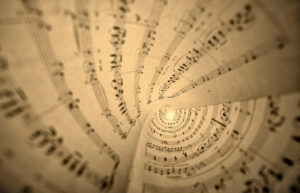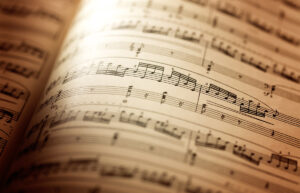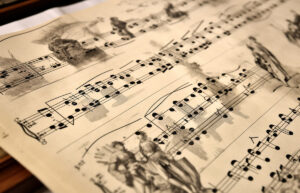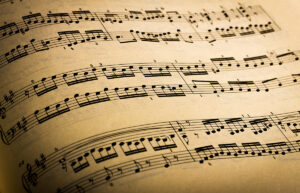What is a Key in Music? Major, Minor & Key Signatures

Welcome to the captivating world of music theory! Imagine keys as secret passageways that unlock the soul of a musical piece, determining its mood, emotion, and structure. Just as keys open doors, musical keys shape melodies and harmonies, influencing how we perceive and experience a composition. Join us on this melodic journey as we unravel the mystery behind what is a key in music and how it transforms mere notes into harmonious storytelling.
Welcome to TheDemoStop, now join the community!
Connect with artists, fans and producers around the world.
What is a key in music?
So, what is a key in music? In music, a key refers to the tonal center or the specific set of notes and chords that revolve around a central note, known as the tonic. It establishes the musical “home base” around which a piece of music revolves.
Keys are defined by a scale, such as major or minor, and are characterized by the relationships between notes, chords, and the overall feeling or mood they create. Keys play a crucial role in shaping a musical composition’s melody, harmony, and emotional impact.
Importance of keys in music theory
Keys in music theory are the organizational backbone of musical compositions. They establish the tonal center, known as the tonic, around which melodies and harmonies find their bearings. This tonal center creates a sense of stability and resolution, crucial for guiding the listener through a piece. Moreover, keys provide a systematic way to arrange chords and notes within a specific scale, like major and minor. This arrangement forms the harmonic structure, allowing composers to craft progressions that create emotional depth.
Understanding what is a key in music helps composers evoke particular emotions or moods. For instance, major keys often convey brightness or cheerfulness, while minor keys tend to evoke a sense of melancholy or introspection. This emotional association contributes significantly to how listeners interpret and connect with music.
Key signatures and how to read them
Simple Major (C, A, G, F, B, D, E)
In music notation, key signatures are visual symbols placed at the beginning of a staff, indicating the key of a piece. Simple major key signatures show the absence of sharps (#) or flats (♭). For example:
- C Major: It has no sharps or flats in its key signature. All the natural notes (white keys on a piano) belong to the C Major scale.
- A Major: Contains three sharps (F#, C#, G#) in its key signature. When playing in A Major, these sharps are consistently applied throughout the piece unless indicated otherwise.
- G Major: its key signature features one sharp (F#), and this sharp is consistently used throughout the music in this key.
Simple Minor Key Signature (D, E, B, G, F, C, A)
Similar to major keys, minor key signatures signify the tonality of a piece. For instance:
- D Minor: No sharps or flats in its key signature. It corresponds to the D Minor scale, which is built upon the D natural minor scale.
- E Minor: Contains one sharp (F#) in its key signature, representing the E Minor scale.
- B Minor: Features two sharps (F#, C#) in its key signature, denoting the B Minor scale.
Sharp key signatures
- Sharp Major (F): F Major has one flat (B♭) in its key signature. It’s the only major key with a single flat.
- Sharp Minor (C, D, F, G): These minor keys have different combinations of sharps in their key signatures. For instance, C Minor contains three flats (B♭, E♭, A♭), while D Minor has one flat (B♭).
Flat key signatures
- Flat Major (A, D, B): Major keys with varying numbers of flats in their key signatures. For instance, A♭ Major contains four flats (B♭, E♭, A♭, D♭), while D♭ Major has five flats (B♭, E♭, A♭, D♭, G♭).
- Flat Minor (A): This refers to the key of A♭ Minor, which contains the same key signature as its relative major, A♭ Major (with four flats).
Musical key characteristics and emotions
| C MAJOR | Innocently Happy |
| C MINOR | Innocently Sad, Love-Sick |
| C# MINOR | Despair, Wailing, Weeping |
| DB MAJOR | Grief, Depressive |
| D MAJOR | Triumphant, Victorious War-Cries |
| D MINOR | Serious, Pious, Ruminating |
How are keys determined in music?
After grasping what is a key in music, let’s unravel into understanding how these keys are determined in music.
Welcome to TheDemoStop, now join the community!
Connect with artists, fans and producers around the world.
Aural perception
A fundamental method for determining the key involves listening to the tonal center of a piece. By focusing on the resolution and the feeling of rest or completion within the music, trained musicians can identify the note that feels like the “home” or tonic. Aural skills and practice enable musicians to recognize this tonal center by ear.
Use key detection software
Key detection software analyzes audio recordings to identify the key of a song. These tools employ algorithms that assess the frequency content, tonal patterns, and chord progressions to estimate the key. While they can offer insights, they might not always be accurate, especially in complex compositions or pieces with modulations.
Looking at the key signature
The key signature, a set of sharps (#) or flats (♭) written at the beginning of a musical staff, indicates the key of a piece. For example, if a piece has three sharps in its key signature (F#, C#, G#), it likely corresponds to the key of A Major or F# Minor. Key signatures help musicians understand the tonality before playing a note.
Take a look at the chord progression
The key of a piece can often be unveiled by examining its chord progressions. The chords employed and their interactions offer insights into the tonal center. For instance, in a composition in C Major, typical chords may involve C, F, G, Am, and so on. Identifying these patterns and connections between chords assists in figuring out the key. Recognizing these recurring patterns and relationships between the chords proves instrumental in deciphering what a key in music is.
Differences between major and minor keys
Major and Minor keys have distinct tonal qualities and characteristic scales.
- Major Keys: Typically convey a brighter or happier mood. They often feature major scales with a specific pattern of whole and half steps. For instance, the C Major scale consists of all the white keys on a piano starting from C.
- Minor Keys: Generally evoke a more melancholic or introspective feel. The natural minor scale is the basis for minor keys, featuring a different arrangement of whole and half steps. For example, the A Minor scale uses all the white keys starting from A.
Conclusion
What is a key in music?
A key in music signifies the central note and its associated scale, shaping the overall sound and emotional feel of a piece.
Importance of key in music theory
After understanding what is a a key in music, it’s essential to explore its significance. The significance of keys in music theory lies in their role as a framework for organizing musical elements. Keys help determine tonality, harmonies, emotional impact, and provide guidance to composers in creating coherent compositions.
Key signatures and how to read them
- Simple Major (C, A, G, F, B, D, E)
- Simple Minor key signature (D, E, B, G, F, C, A)
- Sharp key signatures
- Flat key signatures
Musical key characteristics & emotions
C MAJOR- Innocently Happy
C MINOR- Innocently Sad, Love-sick
C# MINOR- Despair, Wailing, Weeping
DB MAJOR- Grief, Depressive
D MAJOR- Triumphant, Victorious War-Cries
D MINOR- Serious, Pious, Ruminating
How are keys determined in music?
- Aural perception (train your ears)
- Use key detection software
- Looking at the key signature
- Take a look at the chord progression
- Differences between major and minor keys
FAQs
What is a key in music?
A key in music defines the tonal center around which a piece revolves, organizing the notes, chords, and emotional impact of the music.
Why are keys important in music?
In music, keys are important because they provide the tonal center, arrange musical parts, specify the harmonic structure, elicit feelings, direct modulation, and provide a framework for composers to write coherent and emotive pieces.
What is the easiest way to determine the key of a music?
The easiest ways to determine the key of a piece of music are by identifying the tonal center through aural perception, analyzing the key signature, recognizing chord progressions, or utilizing key detection software.
What are the different types of keys in music?
The main types of keys in music include major keys, minor keys (natural, harmonic, and melodic), as well as various modes such as Dorian, Mixolydian, Lydian, and others.
What is the difference between major and minor keys?
Major keys generally convey a brighter, happier sound, while minor keys evoke a more subdued, introspective, or melancholic mood. They differ in their scale patterns, with major keys having a different arrangement of intervals than minor keys, resulting in distinct emotional qualities.
How can keys affect the music?
Keys in music significantly influence the mood, emotion, tonality, and structure of a piece, shaping its overall sound and guiding the listener’s perception and emotional response.
What is key signature?
A key signature in music notation indicates the key of a piece and consists of sharps (#) or flats (♭) placed at the beginning of a staff, determining which notes are consistently altered throughout the composition.
How to read key signatures in music?
To read key signatures in music, identify the sharps (#) or flats (♭) present in the key signature. Sharps or flats dictate which notes are consistently played as altered (raised or lowered) throughout the piece in a particular key.
What is the difference between key signatures and keys?
Key signatures are symbols placed at the beginning of a musical staff indicating which notes are consistently sharp (#) or flat (♭) throughout a piece in a particular key. Keys, on the other hand, refer to the tonal center or scale around which a piece is based, determining the overall sound and emotional feel of the music.
What is a sharp key signature?
A sharp key signature in music notation consists of sharp (#) placed at the beginning of a staff, indicating the notes that are consistently raised by a semitone throughout a piece in a particular key.
What are flat key signatures?
Flat key signatures in music notation consist of flats (♭) placed at the beginning of a staff, indicating the notes that are consistently lowered by a semitone throughout a piece in a specific key.
What are the characteristics of musical keys?
Musical keys have distinct tonal qualities, emotional associations, and characteristic scales.
C MAJOR- Innocently Happy
C MINOR- Innocently Sad, Love-sick
C# MINOR- Despair, Wailing, Weeping
DB MAJOR- Grief, Depressive
D MAJOR- Triumphant, Victorious War-Cries
D MINOR- Serious, Pious, Ruminating































































